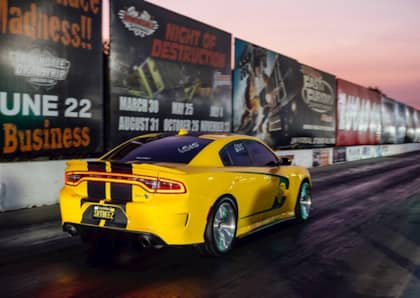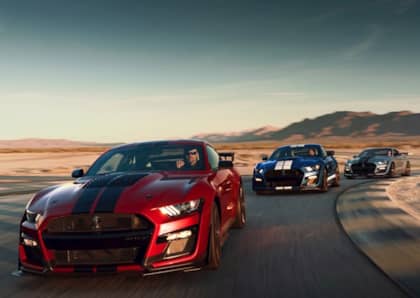6 Factory Supercharged V8s That Crushed The Muscle Car Competition
There's no replacement for displacement—unless it's a supercharger. Being able to force additional air into a motor has long been one of the most reliable, and affordable, ways to generate extra horsepower, and they've become commonplace on the muscle car aftermarket for anyone looking for a quick bump in output.

More recently, Detroit automakers have been willing to provide buyers with supercharged V8 engines right off the showroom floor, with stunning horsepower figures now just a signature on the order sheet away from each of America's traditional sports car builders.
It took a long while to get to where we are today, but the history of supercharged V8 muscle car pioneers dates all the way back to the 1950s. These 6 factory supercharged V8 muscle machines crushed the competition and paved the way for the current bounty of big power options on the market.
1. Ford F-Code 312 V8
Smack dab in the middle of the first-generation Ford Thunderbird's production run came one of the first factory supercharged V8s of the modern era. In 1957 Ford decided to make a blown version of its 312 cubic inch eight-cylinder engine available, and the F-code option featured a hand-built McCullough-Paxton supercharger that boosted horsepower from 285 ponies all the way up to an underrated 300 (alongside 345 lb-ft of torque). This made the car much quicker than its Chevrolet Corvette roadster contemporary, which was stuck with a naturally-aspirated small block V8.

Just 212 examples of the F-code T-Birds were built that year, with hints that Ford was considering homologating the supercharger for use in NASCAR as a response to Chrysler's recent dominance with its Hemi engines (the F-code option did indeed escape the Thunderbird line-up, with a handful making it into sedans like the Fairlane 500).

Unfortunately, NASCAR full-on banned not just superchargers but also fuel injection for the 1958 season, which saw Ford dropping the program altogether before it had a chance to make an impact on the race track.
2. Studebaker R2/R3 289/304 V8
In the early 1960s Studebaker was low on development dollars and looking for cost-effective ways to spice up its existing line-up. Having just introduced the fiberglass-bodied Avanti sports coupe in 1962, the following year it came up with the idea to supercharge its 289 cubic inch V8.

The package was called the R1, and like the F-code it relied on a supercharger built by Paxton (which by this point was a Studebaker subsidiary). Horsepower jumped to 290, which was a bump of 50 ponies versus the naturally-aspirated Avanti.

Racing legend Andy Granatelli was responsible for tuning the R2 engines and the later R3 package that punched out displacement to 304 cubic inches and boosted output to an advertised 335 horses at just over 5,300 rpm (with the undisclosed 'true' dyno number closer to 400 at higher engine RPMs).

The Avanti was a quick car, and it competed well against both the Corvette and the Thunderbird in a straight line. Although the upscale Gran Turismo Hawk also saw a handful of supercharged models built, the real shocker in the supercharged Studebaker lineup was the compact R2/R3 Lark.

Photo credit National Studebaker Museum.
This small, lightweight model (offered as a coupe and a sedan) proved to be a major sleeper, and the few hundred produced were drag strip terrors that still shut down more common muscle cars on the retro circuit today.
3. Ford SVT Cobra 'Terminator' 4.6 V8
You have to jump nearly 40 years into the future to find a factory supercharger muscle car engine that made as much of an impact as Studebaker's R2/R3 combo, but the wait was well worth it. Ford's decision to stick a blower on top of its 32-valve, 4.6-liter aluminum block V8 in the 2003-2004 SVT Cobra created a legend that could back up the 'Terminator' nickname given to it by the Blue Oval's development team.

Rated at 390 horsepower and 390 lb-ft of torque, the Terminator was nearly 30 percent mightier than the Cobra that had preceded it (which used a naturally-aspirated version of the same motor). The Mustang could leap to 60-mph in just 4.5 seconds and burn down the quarter mile in well under 13 seconds, which made it formidable opponent not just to the Chevrolet Camaro SS of its day but also the more expensive Corvette.

Where the Ford SVT Cobra truly shone, however, was in the aftermarket. It was ridiculously easy to swap in a different pulley for its Eaton M-112 supercharger and crank out an extra 60 horses and 100 lb-ft of twist, which was only the starting point for what became a fearsome drag strip dominator and respectable road course handler (thanks to its independent rear suspension setup).

The SVT Cobra raised the bar for affordable performance in the early 2000s, and kicked off an arms race that quickly escalated.
4. Ford Shelby GT500 5.4/5.8 V8
Ford wasn't done with supercharging the Mustang. In the generation that followed the Terminator, Dearborn partnered with Carroll Shelby to produce the Shelby GT500, a series of ante-raising supercharged Mustangs that delivered terrifying amounts of power to the now stick-axle pony car.

Starting in 2007, the GT500 featured an iron block version of the modular 5.4L V8 offered by the Ford GT. SVT swapped in a roots blower for the twin-screw found in the supercar and tuned it to deliver 500 horsepower and 480 lb-ft of torque right out of the box.

This began a scary succession of over-muscled Mustangs, including the GT500 KR (540hp, 510 lb-ft), the 2010-2012 GT500 model that matched the KR's output, and the 2011-2012 GT500s that swapped in a new, lighter aluminum block 5.4L V8 rated at 550 horsepower.

In 2013 Ford decided to go all-in, upping the Shelby GT500's displacement to 5.8L and giving it 662 horsepower and 631 lb-ft of torque. The end result was a difficult-to-tame driving experience that tested the very limits of the S197 platform. After 2014 the supercharged Shelby disappeared from the Mustang mix, but the mark it left on the hearts and minds of muscle car fans changed Detroit's sports car scene forever, spawning two direct competitors that continued its tradition of eye-popping dyno results.
5. Cadillac CTS-V / Chevrolet Camaro ZL1 LSA
When Cadillac unleashed its second-generation CTS-V sedan (and coupe, and wagon) in 2009, it introduced a supercharged V8 based on the popular LS small block architecture.

The LSA motor was rated at 556hp and 551 lb-ft of torque, and like the Terminator before it the 6.2L mill responded very well to light modifications. The CTS-V relied on the hefty V8 until 2015.

If the LSA had been restricted to Cadillac then its impact on modern muscle cars might have been lessened. In 2012, however, General Motors liberated it from its luxury chains and stuff it under the hood of the Chevrolet Camaro ZL1, where it pumped out 580hp and 556 lb-ft of twist.

The ZL1 featured the LSA until the 2015 model year, providing a worthy counterpunch to the Shelby GT500 that wasn't dragged down by the Ford's somewhat twitchy handling characteristics at high speeds.
6. Dodge Challenger/Charger SRT Hellcat
The Dodge Challenger SRT Hellcat appeared on the scene for the 2015 model year, and it landed with extinction-level-event force in the midst of the muscle car market. Chrysler took the 6.4L Hemi V8 block that it had previous installed in standard SRT versions of the car and matched its bore with the smaller 5.7L V8 stroke, creating a 6.2L mill.

The next step was installing a twin-screw supercharger and cranking up the boost to 11.6 psi, for an end result of 707hp and 650 lb-ft of torque.

It's hard to express how much of a game-changer this was for performance car fans. Cresting the 700hp mark was a big deal, especially considering that unlike big-number aftermarket builds, the engine came with a full factory warranty. The drivetrain would eventually be expanded to include the Charger sedan, the Jeep Grand Cherokee SUV, the Ram pickup, and the Dodge Durango SUV.

Chrysler got even crazier with the 6.2L Hellcat motor, eventually releasing a drag-oriented, 840hp version in the Demon (that used a larger twin-screw supercharger and tagged in the air conditioning system as a charge cooler) and a 797hp edition for the Hellcat Redeye. The engine can also be ordered in crate form for project builders, with a 1,000 horsepower 'Hellephant' package pushing out from nearly 7 liters of displacement.
More From Driving Line
- Looking for more monster motor action? Check out the 5 mightiest V10 engines ever built.











